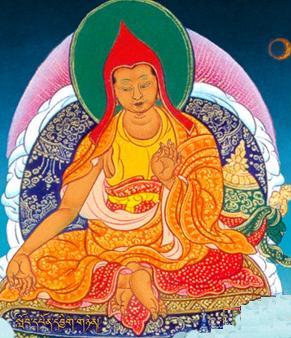Three natures: Difference between revisions
Jump to navigation
Jump to search
mNo edit summary |
m (Fixed Tibetan.) |
||
| (30 intermediate revisions by 5 users not shown) | |||
| Line 1: | Line 1: | ||
'''Three natures''' ([[ | [[image:Vasubandhu.JPG|thumb|[[Vasubandhu]], author of ''[[Treatise on the Three Natures]]'']] | ||
'''Three natures''' (Skt. ''trilakṣana'' or ''trisvabhāva''; Tib. མཚན་ཉིད་གསུམ་, ''tsennyi sum'', [[Wyl.]] ''mtshan nyid gsum'' or རང་བཞིན་གསུམ་, ''rangshyin sum'', Wyl. ''rang bzhin gsum'') — the three categories into which the followers of the [[Mind Only]] school divide all [[phenomena]]: | |||
#''' | #[[Imputed nature|Imputed]] (Skt. ''parikalpita''; Tib. [[ཀུན་བརྟགས་]], Wyl. ''kun btags'') | ||
#''' | #[[Dependent nature|Dependent]] (Skt. ''paratantra''; Tib. [[གཞན་དབང་]], Wyl. ''gzhan dbang'') | ||
#[[Truly existent nature|Truly Existent]] (Skt. ''pariniṣpanna''; Tib. [[ཡོངས་གྲུབ་]], Wyl. ''yongs grub'') | |||
==Explanation== | |||
The [[Buddha]] states in the ''[[Samdhinirmochana Sutra]]'': | |||
*[The imputational character of phenomena] is that which is imputed as a name or symbol in terms of the own-being or attributes of phenomena in order to subsequently designate any convention whatsoever. | |||
*[The other-dependent character of phenomena] is simply the [[dependent origination]] of phenomena. It is like this: Because this exists, that arises; because this is produced, that is produced. It ranges from: 'Due to the condition of [[ignorance]], [[formations|compositional factors]] [arise],' up to: 'In this way, the whole great assemblage of [[suffering]] arises.' | |||
*[The thoroughly established character of phenomena] is the suchness of phenomena. Through [[diligence]] and through proper mental application, [[bodhisattva]]s establish realization and cultivate realization of [the thoroughly established character]. Thus it is what establishes [all the stages] up to unsurpassed, complete, perfect enlightenment.<ref>John Powers, ''Wisdom of Buddha'' (Dharma Publishing, 1995), pages 81-82.</ref> | |||
[[Andy Karr]] writes:<br/> | |||
One way to summarize [the three natures] would be to say that what is imagined by names, thoughts, and so on is the imaginary nature. What is not imagined by names and thoughts but appears due to causes and conditions is the dependent nature. The dependent nature’s emptiness of the imaginary nature is the perfectly existent nature. This is a basic Chittamatra presentation.<ref>Karr, page 99-110.</ref> | |||
==Alternative Translations== | ==Alternative Translations== | ||
*Imagined, | *Imaginary, other-dependent & perfect (Karl Brunnhölzl) | ||
*Imaginary, other-dependent & actual (Buddhavacana Translation Group) | |||
*Imagined, other-dependent & consummate (Jay L. Garfield) | |||
*Imputation, dependence & the absolute ([[Lama Chökyi Nyima]]) | |||
*The three own-beings: the constructed, the interdependent, and the fulfilled (Anacker) | |||
==Canonical Literature== | |||
===Sutras=== | |||
*''[[Lankavatara Sutra]]'' | |||
*''[[Samdhinirmochana Sutra]]'', chapters 6 & 7 | |||
===Shastras=== | |||
*Ch 3 of ''[[Distinguishing the Middle from Extremes]]'' by [[Maitreya]] | |||
*''[[Summary of the Mahayana]]'' by [[Asanga]] | |||
*''[[Treatise on the Three Natures]]'' by [[Vasubandhu]] | |||
==References== | |||
<small><references/></small> | |||
==Further Reading== | ==Further Reading== | ||
*Jay L. | *Garfield, Jay L. 'Vasubandhu's Treatise on the Three Natures' in ''Empty Words: Buddhist Philosophy and Cross-Cultural Interpretation'', Oxford University Press, 2002 | ||
*Karr, Andy. ''Contemplating Reality'' (Boston: Shambala Publications, 2007), Chapter 9 | |||
[[Category:Philosophical Tenets]] | [[Category:Philosophical Tenets]] | ||
[[Category:Three Natures| ]] | |||
[[Category:Chittamatra]] | [[Category:Chittamatra]] | ||
[[Category:Enumerations]] | |||
[[Category:03-Three]] | |||
Latest revision as of 19:09, 2 March 2024

Three natures (Skt. trilakṣana or trisvabhāva; Tib. མཚན་ཉིད་གསུམ་, tsennyi sum, Wyl. mtshan nyid gsum or རང་བཞིན་གསུམ་, rangshyin sum, Wyl. rang bzhin gsum) — the three categories into which the followers of the Mind Only school divide all phenomena:
- Imputed (Skt. parikalpita; Tib. ཀུན་བརྟགས་, Wyl. kun btags)
- Dependent (Skt. paratantra; Tib. གཞན་དབང་, Wyl. gzhan dbang)
- Truly Existent (Skt. pariniṣpanna; Tib. ཡོངས་གྲུབ་, Wyl. yongs grub)
Explanation
The Buddha states in the Samdhinirmochana Sutra:
- [The imputational character of phenomena] is that which is imputed as a name or symbol in terms of the own-being or attributes of phenomena in order to subsequently designate any convention whatsoever.
- [The other-dependent character of phenomena] is simply the dependent origination of phenomena. It is like this: Because this exists, that arises; because this is produced, that is produced. It ranges from: 'Due to the condition of ignorance, compositional factors [arise],' up to: 'In this way, the whole great assemblage of suffering arises.'
- [The thoroughly established character of phenomena] is the suchness of phenomena. Through diligence and through proper mental application, bodhisattvas establish realization and cultivate realization of [the thoroughly established character]. Thus it is what establishes [all the stages] up to unsurpassed, complete, perfect enlightenment.[1]
Andy Karr writes:
One way to summarize [the three natures] would be to say that what is imagined by names, thoughts, and so on is the imaginary nature. What is not imagined by names and thoughts but appears due to causes and conditions is the dependent nature. The dependent nature’s emptiness of the imaginary nature is the perfectly existent nature. This is a basic Chittamatra presentation.[2]
Alternative Translations
- Imaginary, other-dependent & perfect (Karl Brunnhölzl)
- Imaginary, other-dependent & actual (Buddhavacana Translation Group)
- Imagined, other-dependent & consummate (Jay L. Garfield)
- Imputation, dependence & the absolute (Lama Chökyi Nyima)
- The three own-beings: the constructed, the interdependent, and the fulfilled (Anacker)
Canonical Literature
Sutras
- Lankavatara Sutra
- Samdhinirmochana Sutra, chapters 6 & 7
Shastras
- Ch 3 of Distinguishing the Middle from Extremes by Maitreya
- Summary of the Mahayana by Asanga
- Treatise on the Three Natures by Vasubandhu
References
Further Reading
- Garfield, Jay L. 'Vasubandhu's Treatise on the Three Natures' in Empty Words: Buddhist Philosophy and Cross-Cultural Interpretation, Oxford University Press, 2002
- Karr, Andy. Contemplating Reality (Boston: Shambala Publications, 2007), Chapter 9